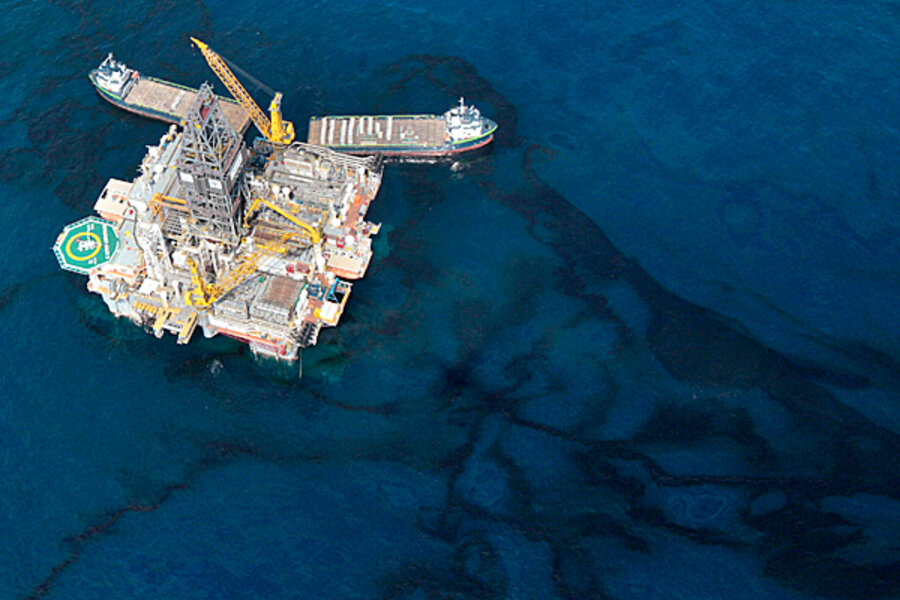BP oil spill: Will the 'sweeping arm system' from the Dutch help?
Loading...
The Dutch government is giving BP officials in the Gulf of Mexico advanced oil recovery technology it says will be more effective than previous efforts.
The technology, called the sweeping arm system, was developed by the Dutch in the early 1970s and has been used to successfully combat oil spills – including high-profile disasters involving the Sea Empress, off the coast of Wales, in 1996; and the Prestige, off the coast of Spain, in 2002.
On Sunday, the Dutch sent six such systems by airfreight to Houston. They’re also sending a six-member team that can reassemble the parts, load them onto tankers, and train a workforce from T&T Marine – a Galveston, Texas, contractor that BP hired to lead the emergency response effort. The operation should be ready for the BP oil spill in 10 days, says Sjon Huisman, an adviser with the Netherlands’s Ministry of Transport, Public Works and Water Management.
IN PICTURES: Louisiana oil spill
The sweeping arm system involves a delicate and slow-moving skimmer that works on the surface of the water, picking up a top layer of oil and water. It moves the concentrated mix to a storage tank where the water and oil are separated and then the water is pumped overboard.
In a press conference Tuesday, US Coast Guard Adm. Thad Allen would neither confirm nor deny that the technology would be used in the Gulf oil spill. Allen would only say that recovery officials were “reaching out to the Netherlands, Canada, and Mexico” for technology assistance. “We’re looking at all sources,” he said.
Dutch companies that manufacture the sweeping arm system first contacted BP officials April 23, three days after the Deepwater Horizon explosion, according to Mr. Huisman, who spoke by phone from his office in The Hague Tuesday. After receiving little reply, the companies turned to his department for help in reaching out to the US State Department, Huisman says.
“We specifically asked those companies that if you have a firm order from BP or the US government, then we can make the arrangements available,” he says. The US Coast Guard made a formal request for the systems May 18, according to Huisman.
The six systems that are being sent are new and are from a special reserve that the Dutch government keeps on hand to combat oil spills off its own shores. Dutch law requires the government to combat oil spills, not the oil-rig operators.
The Dutch government is acting as a conduit between the US and Dutch companies and is not asking for payment, Huisman says. It is relinquishing six systems from its supply of 23 only because Koseq, the Dutch company that manufactures the systems, builds to order and had none available. The government’s only requirement, Huisman says, is that Koseq resupply the government with six more systems when is ready.
The system can collect 20,000 tons of oil at sea in three days, he says.
Calm weather conditions are crucial to the success of the operation, says Wierd Koops, an engineer who helped develop the system and is now a consultant with oil-spill recovery efforts. He spoke from his home in Anna Paulowna in the Netherlands Tuesday. Recovery operators, he says, need to use the system as close to the source of the leak as possible, where oil is at its densest. That makes it easier to collect the oil and separate it from the seawater.
“With this amount of oil, you should try to remove it as soon as possible. Nature will do the rest,” Mr. Koops says. The recovered oil can be reused as fuel for large tankers, he says, but the cost of its recovery exceeds the benefits of its reuse, he adds.
Huisman and Koops would only speculate why recovery officials apparently waited about a month to request the technology. One reason may be Environmental Protection Agency regulations that prevent discharging oil-affected water back into the source.
The regulations are outdated and were not meant to address an oil spill of the magnitude in the Gulf, says Bruce Johnson, professor emeritus of oceanic engineering at the US Naval Academy in Annapolis, Md.
“ ‘One size fits all’ doesn’t work for all oil spills. This is a monster,” Mr. Johnson says. “If you could suck up 80 percent of the oil and discharge 5 percent, you are still catching 75 percent, which is infinitely more than they are currently doing.”
IN PICTURES: Louisiana oil spill
Related:





